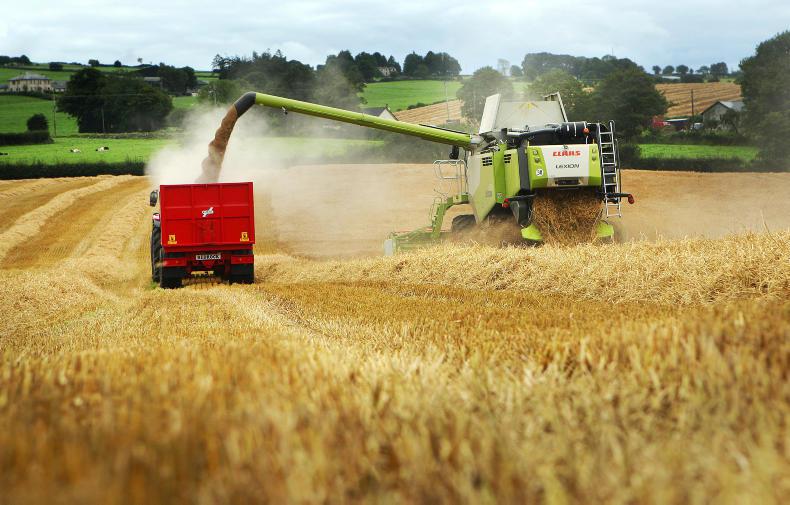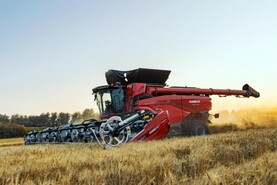With the benefit of hindsight, I was a bit premature in writing the obituary for my spring barley.
It’s not the first time that I’ve written off my cereal acreage, only for a spell of fine, settled weather to come along and save the day. However, if you had seen this field in early September after 140mm of rain during the second half of August, you’d have needed a vivid imagination to picture the field cut and baled in any sort of decent condition.
The finished yield was 2.2t/acre at 16% moisture, and we baled exactly five 4x4 rounds to the acre in perfect order.
Even this poor yield of straw pleases me because when you’re planning on having none, a half crop is more than acceptable
It feels like a 4t crop to me; everything in farming is relative, and having half written (in my head) an article, beginning with the line, “My barley crop has been a total failure due to persistent bad weather”, it feels like victory has been snatched from the jaws of defeat.
Even this poor yield of straw pleases me because when you’re planning on having none, a half crop is more than acceptable. In addition, the beaten-up, weathered state of the straw prior to combining makes it perfect bedding for lambing pens and sheep housing in general.
Last year, we had a good yield of waxy yellow, “perfect” straw, which was a pain in the neck in the wee pens. Time after time, it lapped around ewes’ legs, until she had made herself a long rope, which subsequently could pull her off her feet. (Thinking back, it was sometimes a sign that a ewe wasn’t overly fond of one lamb, and the constant “birling” round the pen in one direction was an indicator that one of the lambs was being rejected.)
Combining
The combine arrived on 17 September, and field conditions had tightened just enough that trafficability was reasonable.
The steeper bits had to be cut downhill, but strong sunshine and a stiff breeze meant the crop flowed over the dividers and fingers easily.
This is heavy land, and it would not have carried machinery much sooner. Ten days previously, it would have been a complete mess.
I don’t quite understand reports of low straw demand
I felt for the larger-scale growers in this area, caught between waiting for settled weather, and having to push on to cover big acreages. There are numerous reports of grain cut in excess of 25%, straw baled up wet, and ruts left that wouldn’t be out of place in a field of vegetables.
And I don’t quite understand reports of low straw demand – plenty of people chopped the end rigs to save trying to dry them, straw yields have been low across the country, and yet there are no emerging tales of panic buying. I fail to see how light crops can translate into anything other than strong prices.
Economics
The profitability of my barley is questionable. In fact, questionable is possibly a euphemism for “will lose money”, but this rented field is beside the water, has the owner’s boat and kayaks in it, and has a long shoreline which has no stock fence, rendering it unsuitable for sheep or cattle on several fronts.
And winter cereals are a non-starter; not only does it lie wet in the winter; it also attracts the attention of half the geese and wading birds in the country.
Speaking of migratory birds, it seems nicely coincidental that on the exact day the harvest finished in this part of county Down, the swallows decided to head off to warmer climes. If I didn’t know better, you’d swear they watched over the whole thing, then one of them said, “Right folks, those eejits have cut all the barley, let’s clear off to somewhere hot”.
Read more
Farmer Writes: gradually moving into the comfort zone
An idle mind is a dangerous thing
With the benefit of hindsight, I was a bit premature in writing the obituary for my spring barley.
It’s not the first time that I’ve written off my cereal acreage, only for a spell of fine, settled weather to come along and save the day. However, if you had seen this field in early September after 140mm of rain during the second half of August, you’d have needed a vivid imagination to picture the field cut and baled in any sort of decent condition.
The finished yield was 2.2t/acre at 16% moisture, and we baled exactly five 4x4 rounds to the acre in perfect order.
Even this poor yield of straw pleases me because when you’re planning on having none, a half crop is more than acceptable
It feels like a 4t crop to me; everything in farming is relative, and having half written (in my head) an article, beginning with the line, “My barley crop has been a total failure due to persistent bad weather”, it feels like victory has been snatched from the jaws of defeat.
Even this poor yield of straw pleases me because when you’re planning on having none, a half crop is more than acceptable. In addition, the beaten-up, weathered state of the straw prior to combining makes it perfect bedding for lambing pens and sheep housing in general.
Last year, we had a good yield of waxy yellow, “perfect” straw, which was a pain in the neck in the wee pens. Time after time, it lapped around ewes’ legs, until she had made herself a long rope, which subsequently could pull her off her feet. (Thinking back, it was sometimes a sign that a ewe wasn’t overly fond of one lamb, and the constant “birling” round the pen in one direction was an indicator that one of the lambs was being rejected.)
Combining
The combine arrived on 17 September, and field conditions had tightened just enough that trafficability was reasonable.
The steeper bits had to be cut downhill, but strong sunshine and a stiff breeze meant the crop flowed over the dividers and fingers easily.
This is heavy land, and it would not have carried machinery much sooner. Ten days previously, it would have been a complete mess.
I don’t quite understand reports of low straw demand
I felt for the larger-scale growers in this area, caught between waiting for settled weather, and having to push on to cover big acreages. There are numerous reports of grain cut in excess of 25%, straw baled up wet, and ruts left that wouldn’t be out of place in a field of vegetables.
And I don’t quite understand reports of low straw demand – plenty of people chopped the end rigs to save trying to dry them, straw yields have been low across the country, and yet there are no emerging tales of panic buying. I fail to see how light crops can translate into anything other than strong prices.
Economics
The profitability of my barley is questionable. In fact, questionable is possibly a euphemism for “will lose money”, but this rented field is beside the water, has the owner’s boat and kayaks in it, and has a long shoreline which has no stock fence, rendering it unsuitable for sheep or cattle on several fronts.
And winter cereals are a non-starter; not only does it lie wet in the winter; it also attracts the attention of half the geese and wading birds in the country.
Speaking of migratory birds, it seems nicely coincidental that on the exact day the harvest finished in this part of county Down, the swallows decided to head off to warmer climes. If I didn’t know better, you’d swear they watched over the whole thing, then one of them said, “Right folks, those eejits have cut all the barley, let’s clear off to somewhere hot”.
Read more
Farmer Writes: gradually moving into the comfort zone
An idle mind is a dangerous thing






 This is a subscriber-only article
This is a subscriber-only article









SHARING OPTIONS: